Samsung extended its long-standing SmartThings IoT platform in late 2020 to include SmartThings Find, opening up new location-based finding possibilities for compatible Galaxy-branded products; from phones to earbuds and wearables.
Fast-forward to the introduction of the Galaxy S21 range during the first half of 2021 and we also met the company’s new SmartTag line – a duo of trackers that let you leverage the full might of the ever-growing SmartThings Find network, with both general and precise finding abilities, as well as richer interaction with other elements of the SmartThings ecosystem.
Designed to take on trackers from established rivals such as Tile and newcomers from Apple, Samsung’s SmartTag and SmartTag+ serve up varying degrees of finding ability to help you keep tabs on your prized possessions, pets or people (with their permission, of course).
It’s worth stating right at the outset that the SmartTag works only with Samsung phones. That’s just like the AirTag: it’s useless if you don’t have an iPhone. So if you don’t own a Samsung phone, you’ll need to read our guide to the best Bluetooth trackers to find an alternative.
Design & build
- Integrated button for smart home functionality
- User-replaceable battery
- Integrated keyring loop
Both SmartTags take the form of rounded, pillowed diamonds, with a hole at one corner to allow for the likes of a keyring, lace or clip (making them more convenient to attach to things than Apple’s AirTags out-the-box).
The lightly textured plastic finish isn’t too slippery but acquires visible scuffs more readily than expected. Their dimensions render these the thickest and heaviest trackers in comparison to their main rivals – Apple’s AirTag and the Tile Pro (even if we’re only talking by a millimetre or so here and a gram there).
When bought individually, both the standard and Plus models come in black, as well as Oatmeal (light brown) and Demin (light blue), respectively. However, the standard SmartTag four-pack also includes one pink and one Mint (pale green) tracker too.
These muted tones make sense in the context of not wanting to draw the attention of thieves who’ve unwittingly nabbed gear that you’re actively able to track, but if it’s just a matter of having misplaced your keys, that fact that they don’t stick out makes them tricky to pick out from a visual scan alone. As such, consider which colour tracker to use on which valuables, relative to the type of finding you’re more likely to need for each (i.e. theft versus loss).
IP53-certification means they lag (slightly) behind their hardier rivals (the Tile Pro is IP55-certified and the AirTag is IP67-compliant), but they’re still protected against the elements to some degree; provided you’re not planning on taking them swimming and they don’t accidentally end up in your washing machine.
You can open the SmartTag up too, although it requires a coin or screwdriver and a fair amount of coercion to pry the back cover off, revealing the user-replaceable battery. This fundamental feature took rival Tile a while come around to implementing on its trackers, so its inclusion here grants the SmartTags much greater long-term use and a greener environmental profile compared to trackers that rely on an integrated cell.
While it’s not immediately obvious, a firm press on the Galaxy SmartTag logo reveals that Samsung’s trackers also feature a physical button, which is used during setup and pairing, along with a few additional situations – more on those later, however.
Network & compatibility
- Works with SmartThings Find network
- Compatible with Galaxy phones running Android 8.0 (or newer)
- UWB features exclusive to only four devices at time of writing
Regardless of the hardware at play, location-based trackers are only as robust as the networks they rely upon and the SmartTags lie locked within Samsung’s walled garden.
This in and of itself isn’t terrible; in terms of a robust network to help find your SmartTagged items, Samsung claims that its SmartThings Find network is now comprised of “more than 70 million helper devices,” all poised to help place your personal effects, while the actual pairing, management and finding of SmartTags has to take place via a compatible Galaxy phone (or tablet).
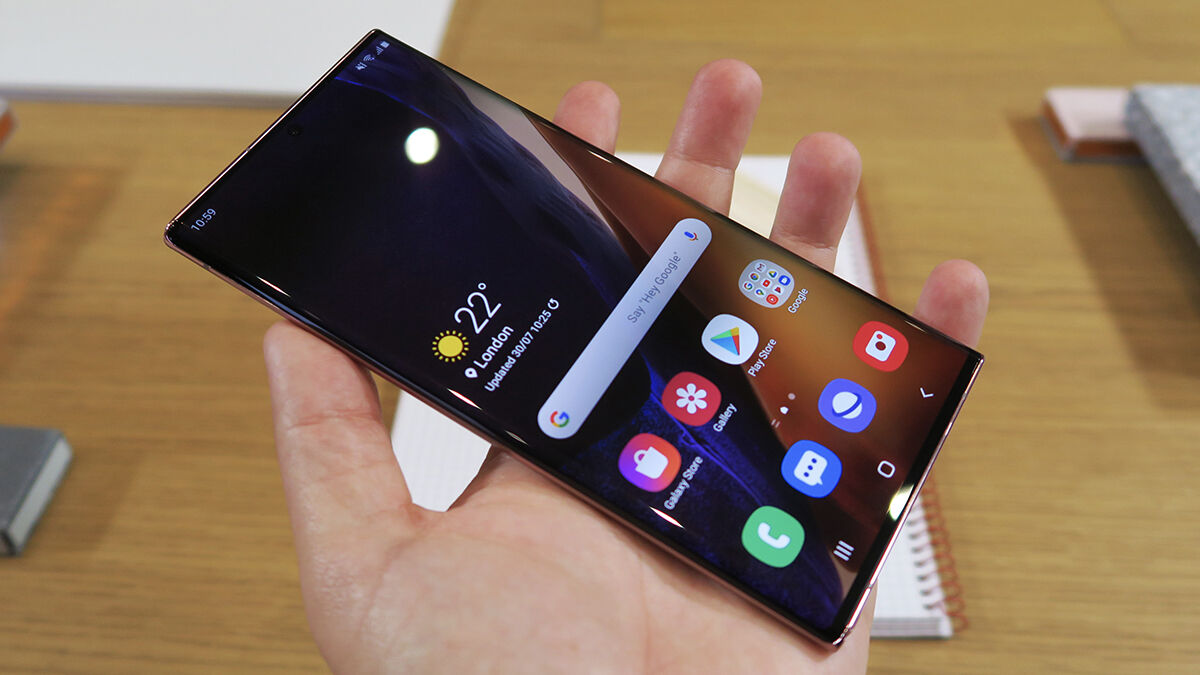
It’s important to note that turning your device (i.e. your smartphone) into a node for the SmartThings Find network is an opt-in process, by default, which is great for security and privacy but hinders the growth of the network, relative to the number of compatible devices Samsung sells.
For comparison, Tile claims to have sold around 35 million trackers, with its network further bolstered by the 30-something industry partners ( companies such as HP and Fitbit, as well as support from Amazon Sidewalk in the US) that help flesh out the infrastructure; its trackers and app are also iOS and Android-compatible.
Apple, meanwhile, has been working on its Find My network far longer than Samsung has and with more devices (“hundreds of millions”, according to the company) keyed into it, has the potential to be the most reliable of the three main players in this space.
It’s also important to consider the market you’re in, geographically speaking. Stateside, Apple rules supreme, whilst Samsung holds more influence in its homeland of South Korea, across Europe and sits near the top in terms of market share in Africa.
While most recent Samsung Galaxy smartphones running Android 8.0 or newer should work with the Bluetooth finding features baked into either SmartTag model, the more precise UWB (ultra wideband) finding that’s exclusive to the SmartTag+ only works with the Samsung Galaxy Note 20 Ultra, Galaxy Z Fold 2, Galaxy S21+ and Galaxy S21 Ultra (being the only Samsung Galaxy phones to feature UWB tech at the time of writing).
While a direct comparison between network sizes is useful, the walled garden effect created by the SmartThings Find network also applies to Apple’s trackers too; with an iPhone 6S or newer needed to use an AirTag and an iPhone 11 or newer needed to use the tag’s UWB-powered AR finding chops; all nestled within the company’s own exclusive Find My network.
Software & features
- Easy setup
- Clear and easy-to-use macro and micro-scale finding
- Unknown Tag Search privacy feature
Although Samsung’s SmartThings app can be found across both the Google Play Store and Apple’s iOS App Store, as already touched upon, when it comes to the SmartTags themselves, compatibility is limited to Samsung’s own Galaxy mobile devices – and those running Android 8 and up, more specifically.
Setup
Setup should be relatively easy, although initially having Nearby Device Scanning (under More Connection Settings) switched off and Flight Mode turned on, both hindered the setup process during review. Flipping the both of these on and off respectively helped kick off the setup/pairing experience as described in the SmartTag’s instructions; with a card popping up on-screen featuring the relevant tracker, once it’s brought in range of a compatible phone.
You can assign SmartTags a category relating to the item they’re attached to, with the SmartThings app offering up a selection of likely items – like keys, bags and pets – or ‘other’ if you decide to get more creative with your usage.
Pairing via the QR code on the SmartTag’s packaging is also an option.
Management
Once you’ve logged into the SmartThings app with your Samsung account and connected your SmartTags, you can view each tag’s location on a map, change the tone and volume that the tags emit when signalled from within the app and setup automations, all with relative ease.
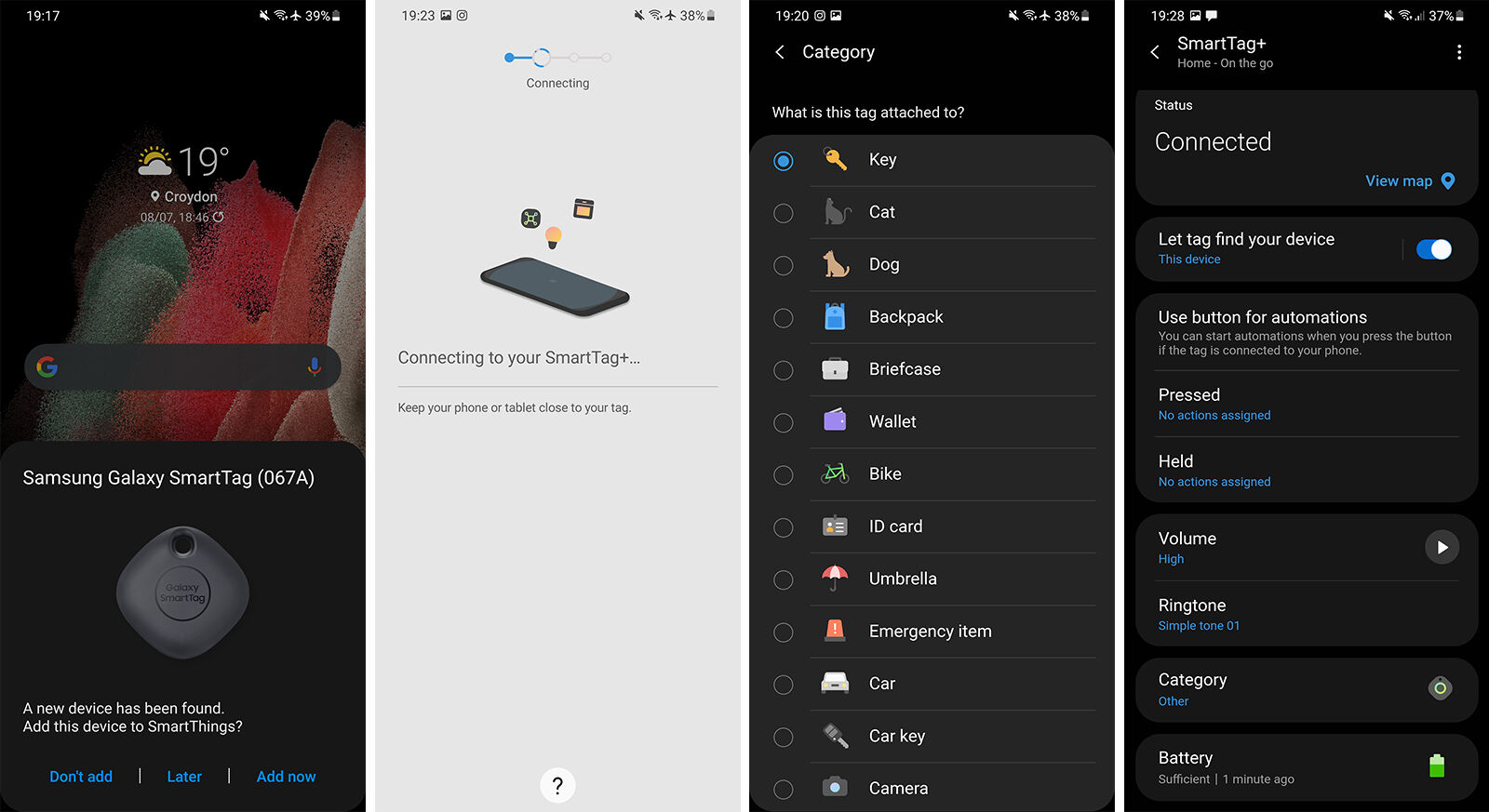
So long as your SmartTag is in range of your connected smartphone, you can fire off two different commands, by either pressing or long-pressing the button built into the tracker’s front. Options include controlling SmartThings-compatible smart home products or running predefined scenes – the functionality of which serves as the ace up the SmartTag’s sleeve, compared to its direct rivals.
Tracking & finding
When it comes to using the SmartTag’s tracking features, the map view gives the best overview of where all of your tracked items are located.
Tapping on a tag in the app will tell you where and when it last checked in with the SmartThings Find network, as well as the ability to navigate to and ring each one, independently.
The Search Nearby option is ideal for when you know you’re within a few feet of an elusive SmartTag, serving up a signal strength gauge that updates in real-time (with distance divided into 0.1-metre increments) as you move around; accompanied by written prompts stating whether you’re getting close or not.
From this screen, you can again make your SmartTag ring and if you’re using the SmartTag+, you also have the option to tap the ‘Find using camera’ button.
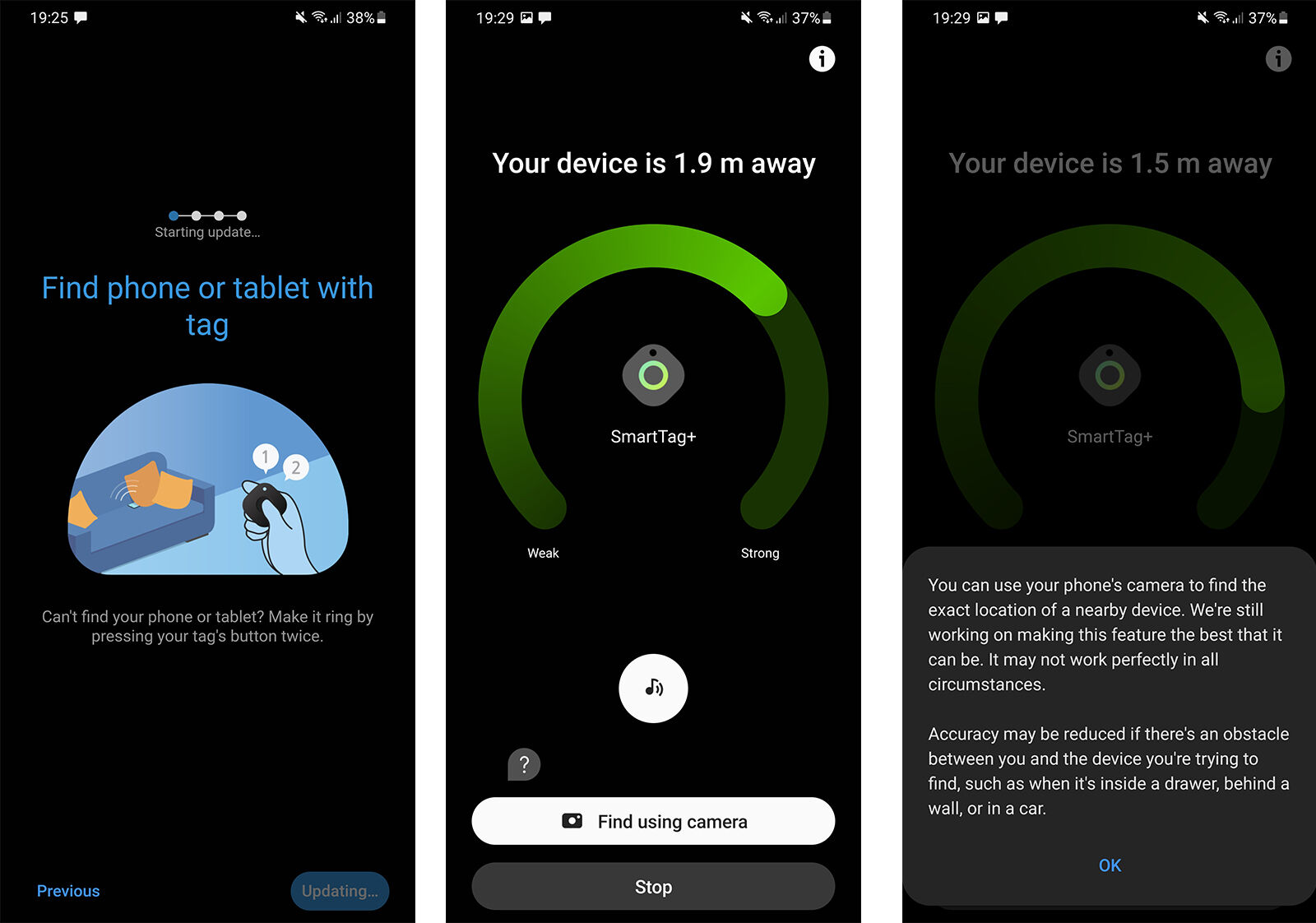
The additional finding power afforded to the SmartTag+ by way of its UWB tech is wholly impressive when put into practice; with an augmented reality overlay atop your phone’s camera feed.
Flashing green arrows direct you to face – and move in the direction of – a nearby SmartTag+, accompanied by haptic pulses as you move closer, while a cloud of green particles floating over the area one should be located shows up once you draw near.
The ability to then ring the tag once again pops up when your phone thinks you’re right on top of it.
For most users, it should prove a simple and self-explanatory experience, with the additional benefits of the SmartTag+ best suited to those who are considering a tracker because they’re prone to losing things themselves, more so than trying to find a stolen item.
Safety & privacy
While the feature didn’t exist at announcement, Samsung was quick to roll out an Unknown Tag Search feature (similar to the AirTag’s feature), meant to assuage concerns of stalking or location tracking by way of a covert SmartTag placed upon your person without your knowledge/consent.
The feature is built into the SmartTag help menu within the SmartThings app and – once you find it – is well laid out and easy-to-use, with a local unknown tag search only taking a minute to perform and able to be executed in the background; with a notification letting you know whether the search pulled anything up.
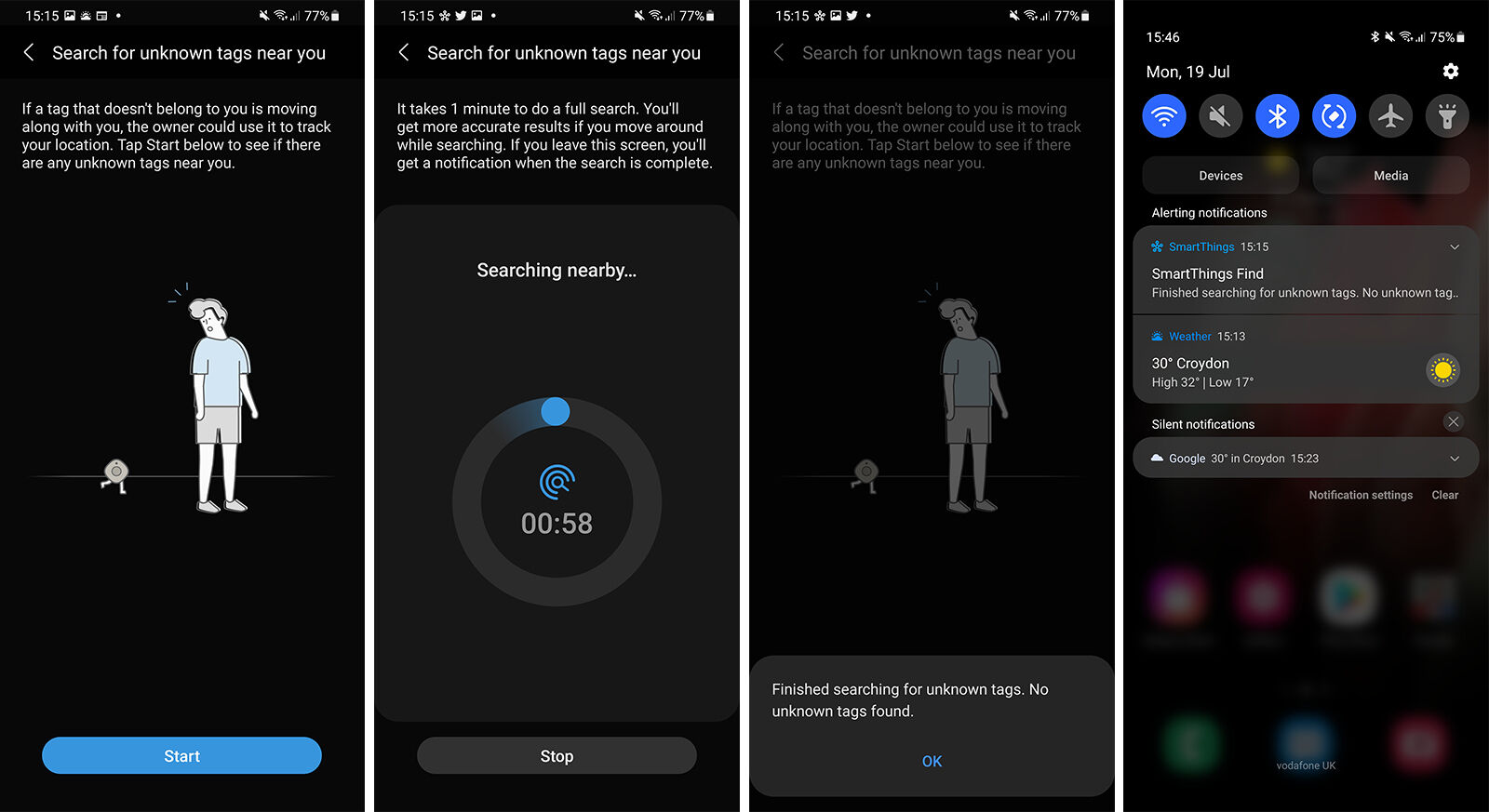
On the flip side, a feature that Apple has already promised to AirTag users with the release of iOS 15 and is already part of Tile’s paid Premium service under the guise of ‘Smart Alerts’ is separation alerts – notifications letting you know when your phone moves out of range of a connected tracker.
Right now, Samsung’s remained silent on the implementation of such a feature and as it currently stands, this represents one of the biggest weaknesses of the SmartTags’ feature set compared to the competition.
Performance
- Network quality varies by region
- Reliable and frequent connection to network
- Real-world BLE range lower than quoted
Long-distance finding is wholly dictated by the fidelity of the SmartThings Find network your SmartTag is missing within. Built-up and more populated areas are likely to increase your chances of finding your tagged item, as there are more points within the local network to bounce off of.
The density of the network affects not only the precise location (on the macro scale of the map view) but also the frequency at which the tag can post its location to the SmartThings Find network.
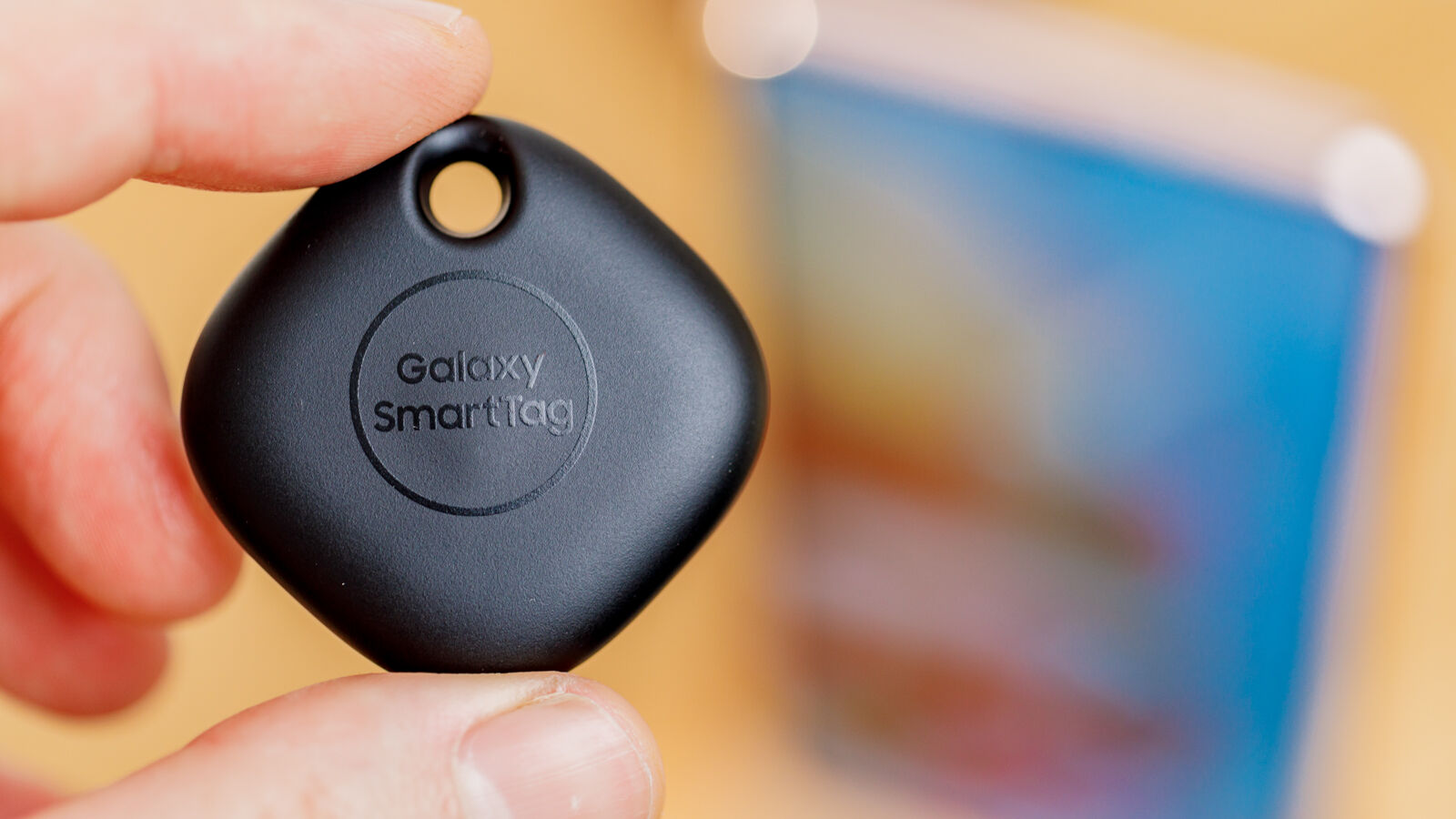
From a tag worn on a train into central London, to one placed within a car moving around rural Sussex, both trackers held up well in terms of consistent visibility within the SmartThings app.
On a micro level, it’s hard to knock even the basic gauge-based finding available to the standard SmartTag tracker, let alone the camera-based AR finding of the UWB-enabled SmartTag+; especially when paired with the reassuringly-loud integrated buzzer.
Samsung quotes a BLE (Bluetooth Low Energy) range of up to 120 metres, which skirts up alongside the Tile Pro’s quoted max range and surpasses that of AirTag’s promised 100 metres. Of course, the caveat to this is that these are perfect condition figures, which can vary wildly in practice if your device’s Bluetooth has to also contend with passing through building materials like glass, wood and brick or dense woodland, so temper your expectations accordingly.
Battery
- Uses standard CR2032 batteries
- SmartTag+ battery life is almost half of SmartTag
- Rivals claim to last longer
As with Apple’s AirTag and Tile’s most recent trackers, both the Galaxy SmartTag and SmartTag+ rely on removable CR2032 coin cell batteries as their power…
